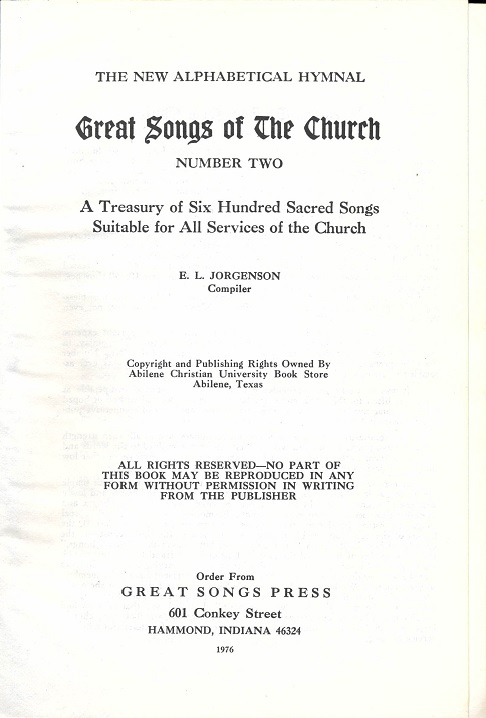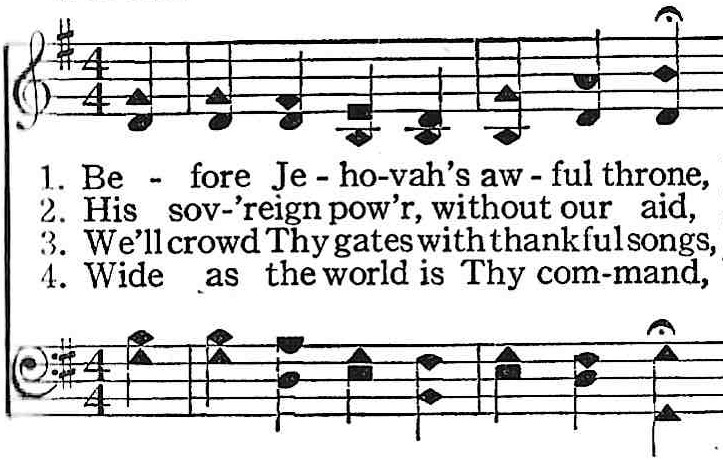



After the American Revolution, there was a religious event that occurred known as the Great Awakening. From this event came the Restoration Movement. The early leaders of this movement were Barton Warren Stone (1772-1844), Thomas Adams (1798-1831), David Purviance (1766-1847), and Rice Haggard (1769-1819). These men decided to call themselves the Christian Church, or the Disciples of Christ. Fifteen years later, they were joined by Thomas Campbell (1763-1854) and his son, Alexander Campbell (1788-1866), after they moved the United States from Ireland.
Individuals, including Alexander Campbell and Stone, would compile hymnbooks for their worship services. Many of these hymnbooks were met with dissatisfaction among the church members. It was Campbell's dream to have one single hymnbook for church. Campbell first published the text-only hymnbook, Psalms, Hymns, and Spiritual Songs, in 1828. He was opposed to using any type of musical notation in his hymnbook.
Amos Sutton Hayden (1813-1880) published The Sacred Melodeon in 1849. Not only did this book have the hymn text associated with music, but the music was written with shape-notes. The music notation that was used was not only Jesse Aiken's shapes, but also the music innovation that Aiken used in his book, The Christian Minstrel.
As time continued, other hymnbooks and shape-note tune books were published. Some individuals would support the idea of having singing schools, while others were against it. At the same time, some congregations would sing with musical instruments, while others would sing a cappella. A division would occur within the Christian Church; at least one reason for the split was over the use of musical instruments. The side that advocated not using instruments and singing a cappella became known as the Church of Christ.
In 1921 Elmer Leon Jorgenson (1886-1968) published Great Songs of the Church. This book was the first major hymnal within the Restoration Movement from someone who did not favor musical instruments in the worship service. As he was compiling his book, his criteria was, "No song can enter there unless it is indispensable, or at least so very excellent, so scriptural, so beautiful, so useful in saving sinners, or in edifying saints, so true and tried…that if we knew the song, we simply would not want to do without it."
Two editions (1922 and 1925) and sixteen printings would come later. In 1937 Jorgenson revised the book renamed it Great Songs of the Church, Number Two.
The first two editions were published using round notes. In the 1922 edition some songs were added, and some were deleted. There was also a supplement that was added. At the same time, there were requests for there being shape-notes. Jorgenson noted that these requests were significant, especially in the South. In September 1925 Jorgenson agreed to this demand and released the new edition using shape-notes. Two months later he released the same book using round-notes. In this latest edition, he again added and deleted songs, and merged the songs in supplement into the main body.
In 1933, Jorgenson added a new section in the back of the book for children's songs and issued these same songs in pamphlets to be used in Sunday Schools.
By 1936, Great Songs of the Church became accepted for use among most of the Churches of Christ congregations. The book was used in over 1,000 churches in the United States, Canada, and almost every continent.
In 1937, Jorgenson felt that Great Songs of the Church needed to be revised. The number of songs increased from 350 to 600, and the title of the book was changed to Great Songs of the Church, Number Two. This revision was also available in round or shape-notes.
Jorgenson sold the print rights of the round-note books to Standard Publishing Company of Cincinnati, Ohio, in 1954. He also sold the rights of the shape-note books to the Christian Chronical of Abilene, Texas. These rights were later acquired by Abilene Christian College Bookstore (now Abilene Christian University Bookstore). This university bookstore has owned and sold Great Songs of the Church ever since.
With the University's acquisition of the shape-note version of the book, a door was opened for a wider and longer exposure than it might have otherwise enjoyed.
Jorgenson passed away in 1968. He had done more to fix and elevate the hymnody of the Churches of Christ than any other person. The hymnody before 1921 was extremely different from that after 1937, and this is due to Jorgenson's efforts.
In the 1970s ACU studied the idea of making another revision of the book. In 1975 a supplement was published, and another revision in 1986. With each revision, the revisionists used Jorgenson's high standards of excellence and work ethics to maintain the excellence of Great Songs of the Church.
In the forward of the 1986 revision, the hymnal committee states that their aim was, "Excellence alone has been the principle of inclusion. The standards followed were truth and soundness, first of all; then strength and clearness, poetic beauty and lyric quality—the music wedded to the words and fit to wing them to the heart." They later stated that the Music Editor paid special attention to make sure that the songs were neither too difficult nor too simplistic while preserving the power of every hymn and song. Unfortunately, this edition was only published using round-notes, and not in shape-notes.
Meanwhile, the shape-note version of Great Songs of the Church, Number Two has remained in publication. The copyright and publishing rights were under the ownership of the Abilene Christian College Book Store, but the books were to be ordered from Great Songs Press. Great Songs Press has been located in different times at Lexington, Kentucky; Chicago, Illinois; Hammond, Indiana; and since 1999 in Mackville, Kentucky. On each occasion the books were printed and bound by Rand McNally and Company.
Great Songs of the Church, Number Two was divided into two parts: Part I is Gospel Songs, and Part II was divided into Hymns, Special Songs, and Songs for Children. The songs in each section are arranged alphabetically according to the first line of the hymn or song.
Great Songs of the Church is currently not in widespread use. However, the books that are in use today were influenced by Jorgenson's work.
Sources:
Beck, Richard Ph.D. "Growing up Shape-Note" Experimental Theology (7 June 2016), <http://experimentaltheology.blogspot.com/2016/06/growing-up-shape-note.html> (27 May 2023).
Hayden, A. S. The Sacred Melodeon, Containing a Great Variety of the Most Approved Church Music, Selected Chiefly from the Old Standard Authors, with Many Original Compositions on a New System of Notation Designed for the use of Churches, Singing Societies, and Academies. (Cincinnati: Moore, Wilstach, & Moore, 1869).
"Hymnal Writers, Compilers and Publishers" Hymnals of the Stone-Campbell Movement, https://www2.lincolnchristian.edu/library/hymnals/writers-compilers-and-publishers.php (10 August 2023).
Ice, Mac. "A Century of Great Songs: E. L. Jorgenson's Remarkable Hymnal" Abilene Christian University Special Collections (20 September 2021)), <https://blogs.acu.edu/specialcollections/exhibits/a-century-of-great-songs-e-l-jorgensons-remarkable-hymnal/> (29 May 2023).
Jorgenson, Elmer Leon. Great Songs of the Church, Number Two. (Abilene, Texas: Abilene Christian College Book Store, 1959).
Jorgenson, Elmer Leon. Great Songs of the Church, Number Two. (Abilene, Texas: Abilene Christian College Book Store, 1971).
McCann, Forrest M. Great Songs of the Church, Revised. (Abilene, Texas: ACU Press, 1986).
McCann, Forrest M. Hymns and History: An Annotated Survey of Sources. (Abilene, Texas: ACU Press, 1997).